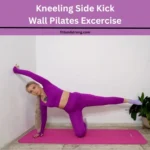Practicing Pilates every day can seem intense. However, its focus on core work, muscle balance, strength, and flexibility makes it a holistic workout. Every day commitment to Pilates offers notable fitness benefits.
As a Pilates instructor, I’ve witnessed the transformative power of this mind-body exercise. It’s not just a class; it’s a journey toward better fitness, strength, and posture. Joseph Pilates, the founder, emphasized controlled movements and core strength. My love for Pilates has led me to try various forms, from classical mat to Megaformer workouts.
Pilates has evolved over the decades since its founding in the 1920s by Joseph Pilates and Clara. Its method combines slow, controlled movements with an emphasis on core strength, flexibility, and balance. This low-impact exercise is perfect for any fitness level.
Being honest, I never thought Pilates was for me until my sister began seeing remarkable results. Despite our age difference (she’s 20 and I’m 30), Pilates addressed my menopausal body with surprising effectiveness.
Pilates shares similarities with yoga, focusing on toning and strengthening without elevating the heart rate. It’s not a high-intensity workout, but after my first session, my stomach muscles were aching – a sign of its effectiveness.

I usually prefer outdoor exercises like running or walking for 30 minutes a day. However, incorporating Pilates into my routine brought new benefits I hadn’t experienced with other exercises. It’s always worth trying something new.
Studies, like those in the Journal of Strength and Conditioning Research, show significant increases in hamstring flexibility from regular Pilates. These findings align with my experience, highlighting Pilates’ comprehensive impact on the body.
The Challenge of Doing Pilates daily revealed unexpected benefits. While I knew it would improve my flexibility and balance, the increase in abdominal endurance and upper-body strength was a welcome surprise.
IS IT GOOD TO DO PILATES EVERY DAY?
Engaging in Pilates every day can be highly effective. This routine becomes more challenging and creative as the body learns to connect. The impact on the muscles and joints is minimal, making it a sustainable practice.
Mixing Up the Routine
I personally experimented with Pilates workouts, starting with a 20-minute beginner routine and varying up to 30-minute sessions. This approach kept the practice fun and challenging, even on days with less time.
While daily Pilates is beneficial, doing it every day in the long term might be overwhelming. It’s essential to listen to your core muscles and adjust your exercise routines accordingly. Incorporating different activities and cardio routines can provide a balanced fitness regimen.
Pilates’ unique mind-body connection is pivotal. As a beginner, daily practice helps understand the movements, making the form more effective over time. However, once this connection is established, practicing every day may not be as necessary.
It’s crucial to have a rest day, regardless of the style of movement or impact level. This rest is vital for both physical and mental benefits, allowing the body and soul to rejuvenate.
Rest days are not just for relaxation; they are when your muscles change and grow. It’s a crucial part of any fitness regimen, ensuring long-term benefits and muscle development.
I Did Pilates Everyday For A Month – Here are the Benefits That I Got
Embarking on a 30-day commitment to daily Pilates practice, I experienced transformative results in my body. This journey was an invigorating fitness challenge.
As a fitness expert, I advise those new to Pilates or returning from an injury to start slower, ensuring a safe and beneficial exercise routine.
In cases of doubt, particularly for new enthusiasts, it’s wise to check with a doctor or personal trainer. Tailored guidance can significantly enhance the effectiveness of your Pilates regimen.
I Got DOMS In My ABS
After switching to daily Pilates for a week, the intensity was palpable. Every single time I laughed, my abdominal muscles felt the burn, a serious beating indeed.
The classes ranged from quick 10 minutes when time was short or traveling to the office, to an intense 60 minutes where I’d unroll my exercise mat and feel my core on fire.

Despite not making me sweat heavily or torch many calories, Pilates worked my entire Core in every move, engaging not just my abdominal muscles, but also my lower back muscles and pelvic floor.
Emphasizing more than just an aesthetic goal, a strong core aids in running faster, lifting heavier, and significantly stabilizing the lower back.
Regularly practicing Pilates, a couple of times per week, not only hurt but also immensely improved my posture, showcasing its multifaceted benefits.
I Mixed Things UP
Pilates, known for being low-impact and widely accessible, offers a style to suit just about everyone. My journey included various forms, keeping it fresh and engaging.
I practiced Pilates in my living room, following a 28-day wall Pilates workout. This 30-minute session quickly became my personal favorite, blending convenience with challenge.
On other days, I attended reformer Pilates classes, where the Reformer machine intensifies the workout by adding resistance and intensity, diversifying my fitness routine.
Mixing things up, I kept my Pilates journey interesting. Regardless of the class, I noticed similarities in the exercises, ensuring a consistently engaging experience.
I Got Weight Loss
While Pilates with a calorie deficit can aid in weight loss, after two weeks of daily practice, my actual weight didn’t change.
I observed noticeable changes in my body’s appearance and sensation. My attire felt more relaxed, indicating a reduction in inches rather than actual weight.
In my experience, Pilates is one of the best ways to build lean muscle through low-impact movement, not necessarily for quick weight loss.
Pilates stretches and strengthens muscles, resulting in a super-defined and sculpted look. This core work supports the spine and stabilises hips.
For those looking to lose weight, combining Pilates with cardiovascular exercise might be more effective. Pilates enhances deep core strength and overall muscle efficiency.
Pilates and cardio together can lead to more effective weight loss, as Pilates provides intricate muscle strengthening that supports larger muscles in cardio workouts.
I Felt Less Stressed
As a real believer in the joy of moving, I embraced Pilates for its calming nature, not just to lose weight or burn calories.
Attending a Pilates class during my lunchbreak was refreshing. I could return to the office without being a sweaty mess, feeling relaxed and rejuvenated.
Pilates classes often incorporate stretching and are centered around breath control. This focus on breath during movements profoundly engaged my core and soothed my mind.
Focusing on my breath during workouts forced me to stay present, freeing me from worries about unread emails or shopping lists, reducing stress significantly.
I FELT IT IN MY NECK
As a seasoned Pilates instructor, after a couple of weeks into the daily practice, I began feeling discomfort in my neck.
Upon reflection and consulting, I realized neck pain was a clear sign of not engaging the core sufficiently in various exercises.
When exercises involved raising the head and neck from the mat, it was crucial to remember tucking the chin towards the chest instead of jutting it towards the ceiling. This adjustment ensures the abs stay engaged for the entire workout.
I Noticed Less Pain in My Lower Back
As a Pilates instructor with a history of sciatica from a horse riding accident in my teens, I often experienced a tight lower back, especially after long periods of sitting down.
Incorporating daily Pilates practice was transformative. It not only helped loosen and stretch my back but also focused on strengthening my lower back muscles, alleviating tightness.
A study in the Journal of Physical Therapy Science supports this, showing Pilates significantly improves pain relief in individuals with chronic back pain.
Important to note, practicing Pilates with correct form is key, especially keeping the lower back pressed into the mat during exercises. Arching your lower back can exert pressure on the spine.
For those who suffer from back pain, I always suggest talking to your instructor beforehand to tailor the practice appropriately.
Enhanced Flexibility
Flexibility is more than just touching your toes; it encompasses a full range of motion in the body. Pilates improves flexibility in the shoulder joints, spine, pelvis, knees, ankles, and feet. This increased flexibility helps you move more fluidly and reduces the risk of injury.
Regular Pilates practice enhances not just flexibility but also the ease of movement in day-to-day life. By working various joints, including shoulder joints, spine, and pelvis, it helps in maintaining a healthy range of motion.
Improved Balance and Coordination
In Pilates, balance isn’t just standing on one foot or walking a straight line; it’s about mastering everyday movements. You learn to maintain a neutral spine while inhaling and exhaling, harmonizing your muscular system and reducing injury risk.
Balance and coordination are critical for daily activities. Pilates trains the body to balance effectively, enhancing stability in movements and reducing the risk of injury.
Increased Energy Levels
Performing Pilates movements can significantly improve circulation and boost oxygen intake, which in turn increases energy levels. As noted by Choza, Pilates helps students breathe better and feel more energized.

With improved circulation and oxygen intake from Pilates, there’s a noticeable increase in energy levels. This boost in energy makes you feel more energized and ready to tackle the day.
Mental and Emotional Benefits
Pilates isn’t just about physical benefit; research highlights significant mental health benefits, akin to those experienced in yoga practices.
Studies indicate that a regular Pilates practice can notably reduce feelings of anxiety and depression, improving quality of life, especially in overweight patients.
Kristin McGee, a renowned celebrity Yoga and Pilates teacher and pioneer of Peloton’s interactive classes, equates consistent Pilates practice to meditation or a moving meditation.
Engaging in Pilates, we stay present in each move, using our breath to connect deeply with our core. This practice is emotionally freeing and reminds us to stay connected to our deeper instincts and true internal cues in life.
Another key benefit of Pilates is stress relief. It heightens awareness of your body and deep breath work helps regulate the nervous system.
This mindful approach keeps cortisol levels, the stress hormone responsible for fight-or-flight mode, at bay, ensuring a calmer, more balanced state of mind.
Can You Do Pilates Every Day?
Contrary to popular belief, Pilates isn’t too difficult or challenging to practice every day. It’s a misconception that it should only be done a few times per week.
Incorporating Pilates frequently into your routine leads to quicker adaptation by your body, resulting in faster results. This routine helps your muscles to become familiar with the movements and challenges.
Improving your form becomes more noticeable when you do Pilates every day. You’ll see improvements in how you execute each exercise, as your body begins to automatically follow the correct movements.
Another key benefit of daily Pilates is the reduced risk of injuries. Your body becomes more accustomed to the stress, making your muscles, tendons, and ligaments stronger and more resistant.
As your body adjusts to this new level of activity, your muscles, tendons, and ligaments become stronger and more resistant to injury, enhancing overall fitness and well-being.
The Effectiveness of Routine Practice
Daily Pilates not only makes your body work less hard each time but also ensures that the workout remains effective and beneficial over the long term.
How Long Does It Take To See Results From Pilates
Engaging in Pilates every day for two weeks might not be enough to witness all benefits, such as significant weight loss. However, other results become evident after the first week.
Mental clarity often improves quickly, with lower stress levels and stronger core muscles noticeable. Additionally, posture tends to get much better within this period.
According to Hilliard, results can be felt almost immediately. For visible changes, she suggests doing Pilates three to four times per week.
Speir concurs, noting that fast results in Pilates don’t necessarily require a daily routine. Similar to yoga, doing it almost every day can accelerate progress.
For fantastic results, I recommend Pilates three times per week. For absolutely incredible and quicker results, up to six days a week is ideal.
Notably, within two weeks, you’ll feel much stronger and energized. However, Pilates targets intricate muscles, so noticeable physical results are best seen after six to eight weeks of consistent practice.
What Do The Experts Say?
Experts acknowledge the benefits of doing Pilates every day, stressing the importance of listening to your body and finding what works best for you.
For those new to the workout, they recommend starting with a few sessions per week and gradually increasing frequency as your body adjusts.
It’s crucial to follow the guidelines we talked about above for safely incorporating Pilates into your routine, ensuring a smooth and beneficial transition.
Give Pilates a try yourself and see how you feel. There’s no wrong way to do Pilates; the key is to have fun and find what works best for your body.
Who knows, you might end up loving it so much that you make it a daily habit. Pilates offers flexibility in routine and intensity, making it a sustainable practice for many.
Conclusion
the journey through daily Pilates practice reveals a range of benefits that extend beyond the physical. While significant weight loss may not be immediately noticeable within the first few weeks, the practice brings about subtle yet impactful changes.
Improvements in mental clarity, reduced stress levels, enhanced core strength, and better posture are among the early benefits that one can expect to experience.
Experts like Hilliard and Speir suggest that while immediate feelings of improvement are common, visible and more profound results, particularly in physical appearance and muscle tone, generally manifest over a longer period.
A consistent practice of three to six times per week is recommended for the best results. The timeline for noticing these changes can vary from two to eight weeks, indicating that patience and consistency are key in Pilates.
Ultimately, Pilates is not just a physical exercise; it’s a holistic approach to well-being, harmonizing the body and mind, and offering a path to a healthier, more balanced lifestyle.





